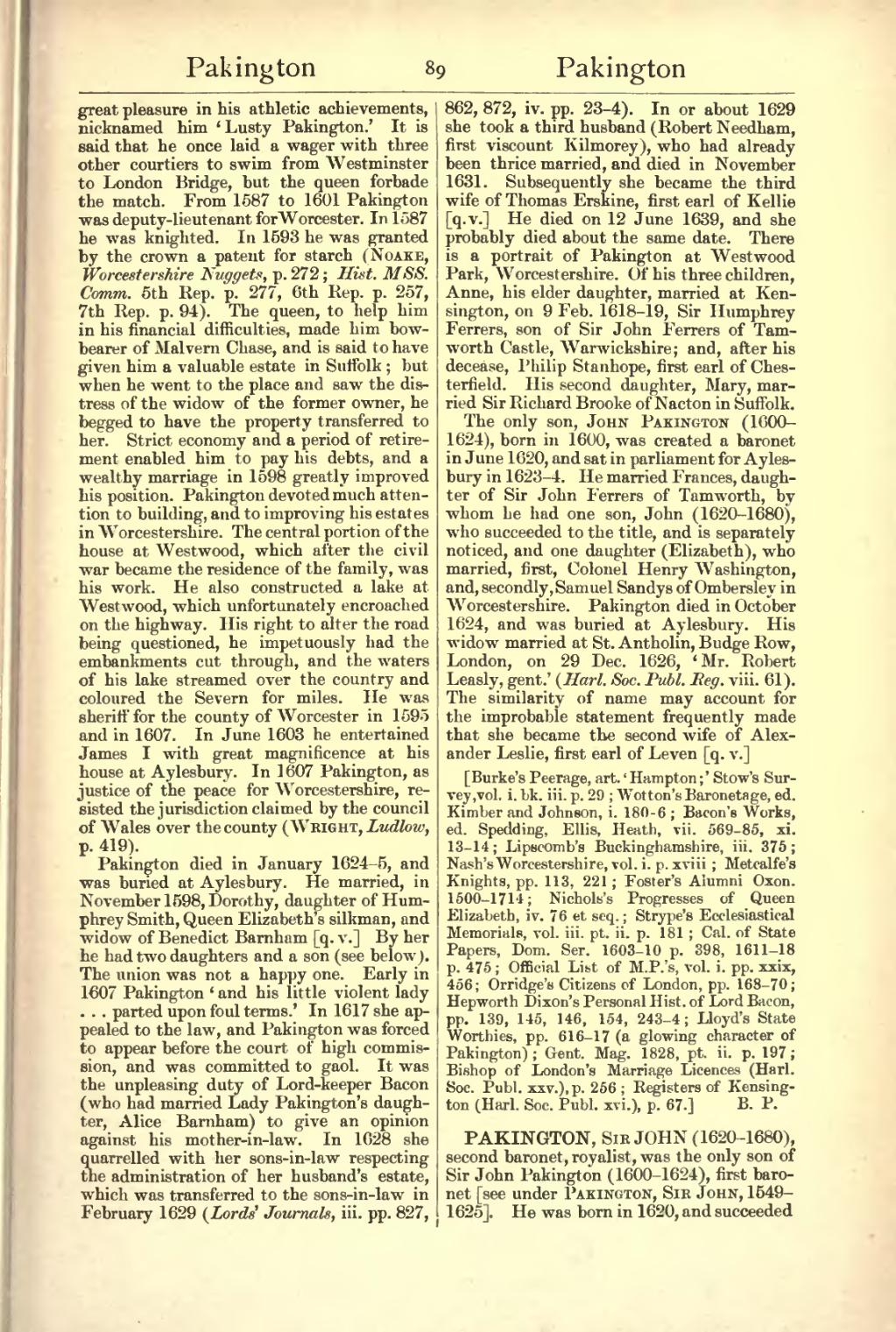great pleasure in his athletic achievements, nicknamed him ‘Lusty Pakington.’ It is said that he once laid a wager with three other courtiers to swim from Westminster to London Bridge, but the queen forbade the match. From 1587 to 1601 Pakington was deputy-lieutenant for Worcester. In 1587 he was knighted. In 1593 he was granted by the crown a patent for starch (Noake, Worcestershire Nuggets, p. 272; Hist. MSS. Comm. 5th Rep. p. 277, 6th Rep. p. 257, 7th Rep. p. 94). The queen, to help him in his financial difficulties, made him bow-bearer of Malvern Chase, and is said to have given him a valuable estate in Suffolk; but when he went to the place and saw the distress of the widow of the former owner, he begged to have the property transferred to her. Strict economy and a period of retirement enabled him to pay his debts, and a wealthy marriage in 1598 greatly improved his position. Pakington devoted much attention to building, and to improving his estates in Worcestershire. The central portion of the house at Westwood, which after the civil war became the residence of the family, was his work. He also constructed a lake at Westwood, which unfortunately encroached on the highway. His right to alter the road being questioned, he impetuously had the embankments cut through, and the waters of his lake streamed over the country and coloured the Severn for miles. He was sheriff for the county of Worcester in 1595 and in 1607. In June 1603 he entertained James I with great magnificence at his house at Aylesbury. In 1607 Pakington, as justice of the peace for Worcestershire, resisted the jurisdiction claimed by the council of Wales over the county (Wright, Ludlow, p. 419).
Pakington died in January 1624–5, and was buried at Aylesbury. He married, in November 1598, Dorothy, daughter of Humphrey Smith, Queen Elizabeth's silkman, and widow of Benedict Barnham [q. v.] By her he had two daughters and a son (see below). The union was not a happy one. Early in 1607 Pakington ‘and his little violent lady … parted upon foul terms.’ In 1617 she appealed to the law, and Pakington was forced to appear before the court of high commission, and was committed to gaol. It was the unpleasing duty of Lord-keeper Bacon (who had married Lady Pakington's daughter, Alice Barnham) to give an opinion against his mother-in-law. In 1628 she quarrelled with her sons-in-law respecting the administration of her husband's estate, which was transferred to the sons-in-law in February 1629 (Lords' Journals, iii. pp. 827, 862, 872, iv. pp. 23–4). In or about 1629 she took a third husband (Robert Needham, first viscount Kilmorey), who had already been thrice married, and died in November 1631. Subsequently she became the third wife of Thomas Erskine, first earl of Kellie [q. v.] He died on 12 June 1639, and she probably died about the same date. There is a portrait of Pakington at Westwood Park, Worcestershire. Of his three children, Anne, his elder daughter, married at Kensington, on 9 Feb. 1618–19, Sir Humphrey Ferrers, son of Sir John Ferrers of Tamworth Castle, Warwickshire; and, after his decease, Philip Stanhope, first earl of Chesterfield. His second daughter, Mary, married Sir Richard Brooke of Nacton in Suffolk.
The only son, John Pakington (1600–1624), born in 1600, was created a baronet in June 1620, and sat in parliament for Aylesbury in 1623–4. He married Frances, daughter of Sir John Ferrers of Tamworth, by whom he had one son, John (1620–1680), who succeeded to the title, and is separately noticed, and one daughter (Elizabeth), who married, first, Colonel Henry Washington, and, secondly, Samuel Sandys of Ombersley in Worcestershire. Pakington died in October 1624, and was buried at Aylesbury. His widow married at St. Antholin, Budge Row, London, on 29 Dec. 1626, ‘Mr. Robert Leasly, gent.’ (Harl. Soc. Publ. Reg. viii. 61). The similarity of name may account for the improbable statement frequently made that she became the second wife of Alexander Leslie, first earl of Leven [q. v.]
[Burke's Peerage, art. ‘Hampton;’ Stow's Survey, vol. i. bk. iii. p. 29; Wotton's Baronetage, ed. Kimber and Johnson, i. 180–6; Bacon's Works, ed. Spedding, Ellis, Heath, vii. 569–85, xi. 13–14; Lipscomb's Buckinghamshire, iii. 375; Nash's Worcestershire, vol. i. p. xviii; Metcalfe's Knights, pp. 113, 221; Foster's Alumni Oxon. 1500–1714; Nichols's Progresses of Queen Elizabeth, iv. 76 et seq.; Strype's Ecclesiastical Memorials, vol. iii. pt. ii. p. 181; Cal. of State Papers, Dom. Ser. 1603–10 p. 398, 1611–18 p. 475; Official List of M.P.'s, vol. i. pp. xxix, 456; Orridge's Citizens of London, pp. 168–70; Hepworth Dixon's Personal Hist. of Lord Bacon, pp. 139, 145, 146, 154, 243–4; Lloyd's State Worthies, pp. 616–17 (a glowing character of Pakington); Gent. Mag. 1828, pt. ii. p. 197; Bishop of London's Marriage Licences (Harl. Soc. Publ. xxv.), p. 256; Registers of Kensington (Harl. Soc. Publ. xvi.), p. 67.]
PAKINGTON, Sir JOHN (1620–1680), second baronet, royalist, was the only son of Sir John Pakington (1600–1624), first baronet [see under Pakington, Sir John, (1549–1625)]. He was born in 1620, and succeeded
